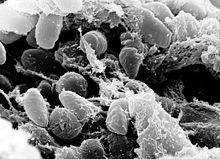Yersinia pestis
Ang Yersinia pestis (Y. pestis; dating Pasteurella pestis) ay isang gram-negatibong, hindi-motilong coccobacillus bacterium na walang spora na nauugnay sa parehong Yersinia pseudotuberculosis at Yersinia enterocot litica. Ito ay isang pakultatibong anerobikong organismo na humahawa sa mga tao sa pamamagitan ng pulgas ng oriental na daga (Xenopsylla cheopis).[1] Ito ay nagsasanhi ng salot gaya ng unang pandemikong salot at Itim na Kamatayan. Ang salot na ito ay may tatlong anyo, pneumoniko, septisemiko, at buboniko. Ito ay natuklasan noong 1894 ng doktor na Swiss/Pranses at baketyologong si Alexandre Yersin.
| Yersinia pestis | |
|---|---|

| |
| A scanning electron micrograph depicting a mass of Yersinia pestis bacteria in the foregut of an infected flea | |
| Klasipikasyong pang-agham | |
| Dominyo: | Bacteria |
| Kalapian: | Pseudomonadota |
| Hati: | Gammaproteobacteria |
| Orden: | Enterobacterales |
| Pamilya: | Yersiniaceae |
| Sari: | Yersinia |
| Espesye: | Y. pestis
|
| Pangalang binomial | |
| Yersinia pestis (Lehmann & Neumann, 1896)
van Loghem, 1944 | |
| Kasingkahulugan | |
| |
Mga sanggunian
baguhin- ↑ Ryan, KJ; Ray, CG, mga pat. (2004). Sherris Medical Microbiology (ika-4th (na) edisyon). McGraw Hill. pp. 484–88. ISBN 978-0-8385-8529-0.
{{cite book}}: CS1 maint: date auto-translated (link)